The Importance of Proactive Recruiting in 2022

Check out these tips to prepare for your next recruitment challenge!
You know as a recruiter that the employment market is constantly changing. While volatility may not be predictable, it can be anticipated. In recent years we have seen sudden and erratic changes such as the 2016 federal hiring freeze and the 2020 coronavirus outbreak. We've seen the emergence of new, groundbreaking technologies like artificial intelligence, blockchain, and virtual reality. Having a strong employer brand will help you weather any changes in the employment market.
Table of Contents
Maintaining your employer brand should be a top priority. Keep building your talent pipeline to stay ahead of the competition.
Maintaining your employer brand should be a top priority.
Creating an employer brand takes months, and its effects build up over time. If you don't have a well-established, sought-after brand, you can't afford to let your employer brand take a break when hiring goals are reduced. Doing so will put you at a significant disadvantage when hiring becomes a priority again. Rather than retreating to less effective recruiting approaches in times of uncertainty, it’s important to continue to prioritize proactive approaches like your employer brand.
EMPLOYER BRANDING
Employer branding is the process of managing and influencing a company's reputation as an employer.
IMPROVE YOUR COST-PER-HIRE
The cost-per-hire is calculated by taking the total cost of the hiring process and dividing it by the number of new hires. All expenses from the moment a new role opens until the offer is accepted must be accounted for, including travel, ads, agency fees, time spent recruiting, employer branding, productivity loss, and salary. One factor that is not considered in this calculation is the fact that a strong employer brand can reduce your cost per hire by 50 percent. However, if you have a poor employer brand, you will have to offer a 10 percent higher salary in order to attract qualified candidates. Removing employer branding from your recruitment strategy will be more costly in the long run.
HIRING FREEZES ≠ JOB SEARCH FREEZES
If you are forced to cut roles or are facing a hiring freeze, it is even more important to maintain your employer brand through tough times.
Market volatility often has employees questioning if their employer is actually a company they want to work for. You put yourself at risk of losing top candidates and maybe even your current employees if you don't have an employer brand when job seekers are looking for employment. By improving your employer brand, you can improve employee retention rates and join the 30 percent of companies that reap the benefits of this strategy.
SLOW AND STEADY WINS THE RACE
Because work takes up so much of a person's life, choosing the right employer is a very important decision. Job seekers should take their time to research their options and make sure they are making the best choice for themselves.
According to our data, on average, people complete five job search-related activities before applying. Having a strong employer brand with informative content will help candidates learn more about your company faster, ease their minds about you as an employer and ensure them that they are making the right decision in applying for your open roles. Keep your employer brand at the forefront of candidates' minds so that when hiring returns to normal, you will be the first employer that candidates think of when looking for a job. This will reduce your time-to-hire, and ultimately reduce your cost-per-hire.
Keep building your talent pipeline to stay ahead of the competition.
The employer brand will play a crucial role in the talent pipeline's success. If potential candidates are unaware of the company, they cannot apply for available positions. Top candidates are only on the job market for a short time, so it's important to have an efficient talent pipeline that establishes a meaningful connection with candidates early on.
It is important to continuously attract candidates and build your talent pipeline so when new roles open up, you can fill them quicker; saving on costs, time and productivity.
PREPARE FOR EMPLOYEE TURNOVER
The turnover rate for employees is the percentage of employees who leave a company during a certain period of time. This includes both voluntary and involuntary separations. The average annual turnover rate is 19 percent, but this changes by role and industry. Despite how unstable the employment market is, you will still experience employee turnover and filling these essential positions will remain a necessity.
SHRM reports that the average time-to-fill is 36 days, but this will rise for positions that are hard to fill, like software engineers. A strong talent pool will help you meet these hiring needs and minimize productivity loss.
It is essential to identify which recruitment strategies are key to supplementing your talent pipeline and to continue investing in these strategies. This will reduce the risk of an increase in time to fill, and ultimately save your business money.
GET CREATIVE WITH SOURCING STRATEGIES
All of these sourcing strategies are low-cost investments and will help you find truly great candidates without depleting resources.
Employee referrals are one of the best sourcing strategies, improving time-to-fill by 40%.
Boolean search is an important tool for sourcing candidates for hard-to-hire roles. Your applicant tracking system (ATS) is a great resource for finding prospective candidates because it includes anyone who has ever engaged with your employer brand.
Even during volatile employment markets, company goals remain unchanged. A strong talent pipeline and employer brand will help your team be largely unaffected by changes in the employment market. In addition, when the market rebounds - as it always does - you will be ready due to your proactive recruitment strategy.














